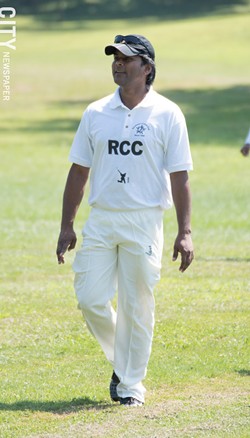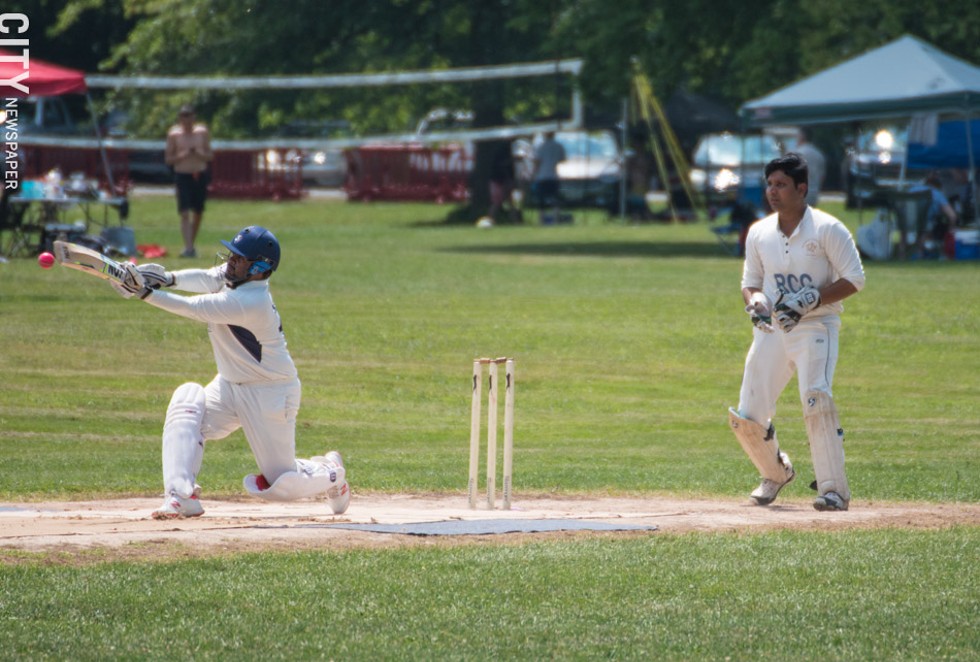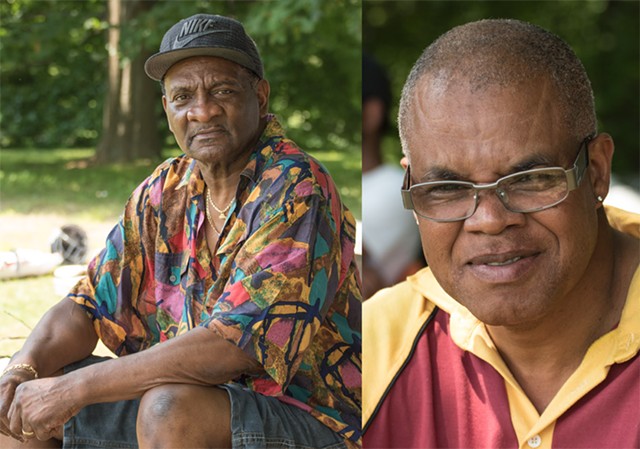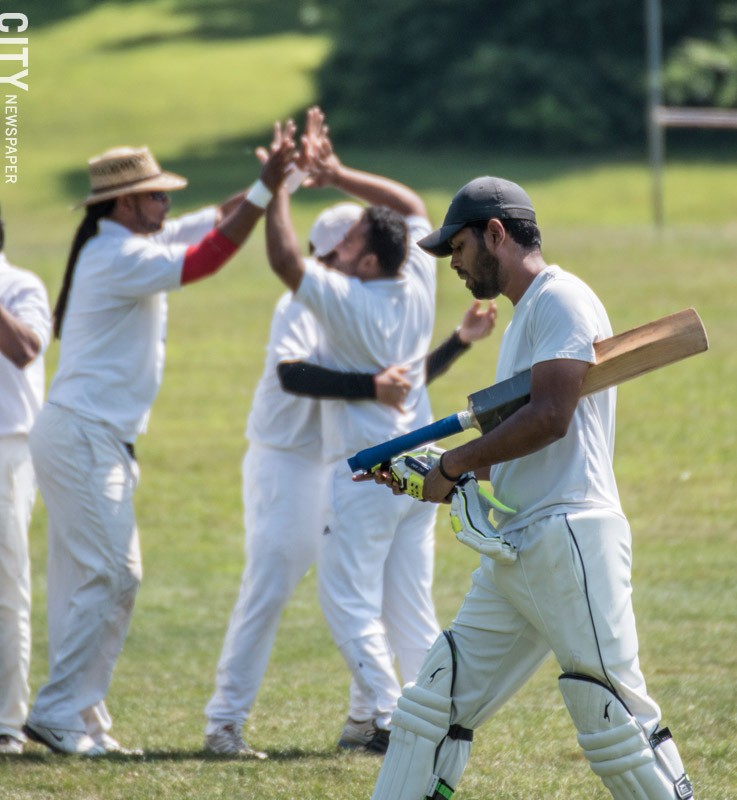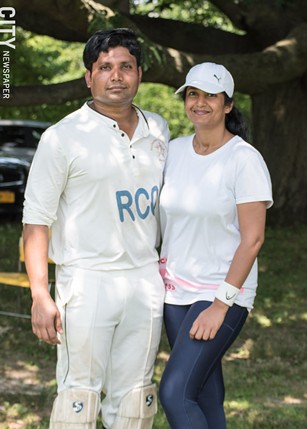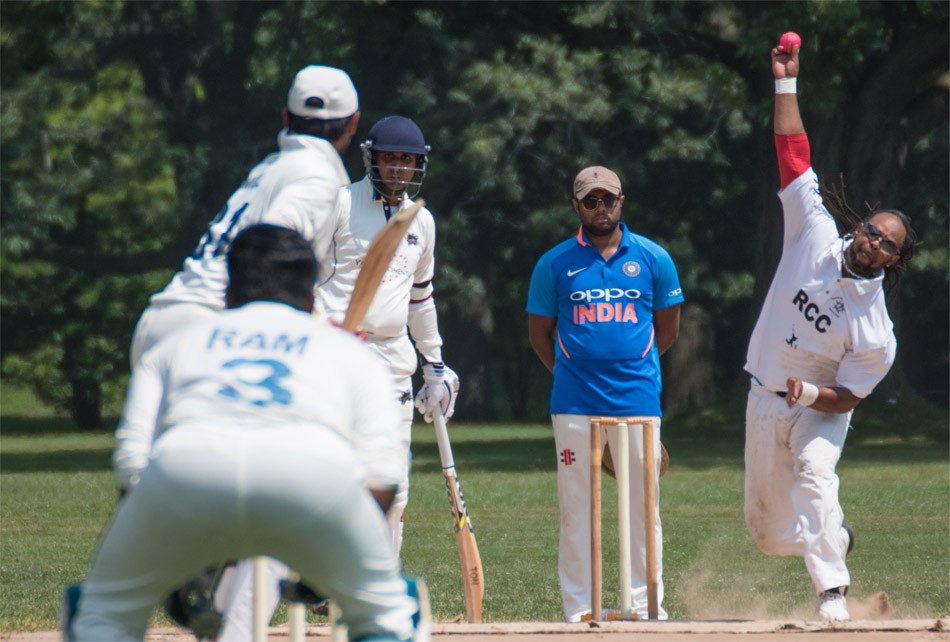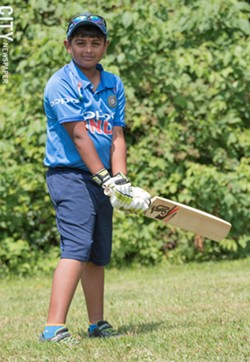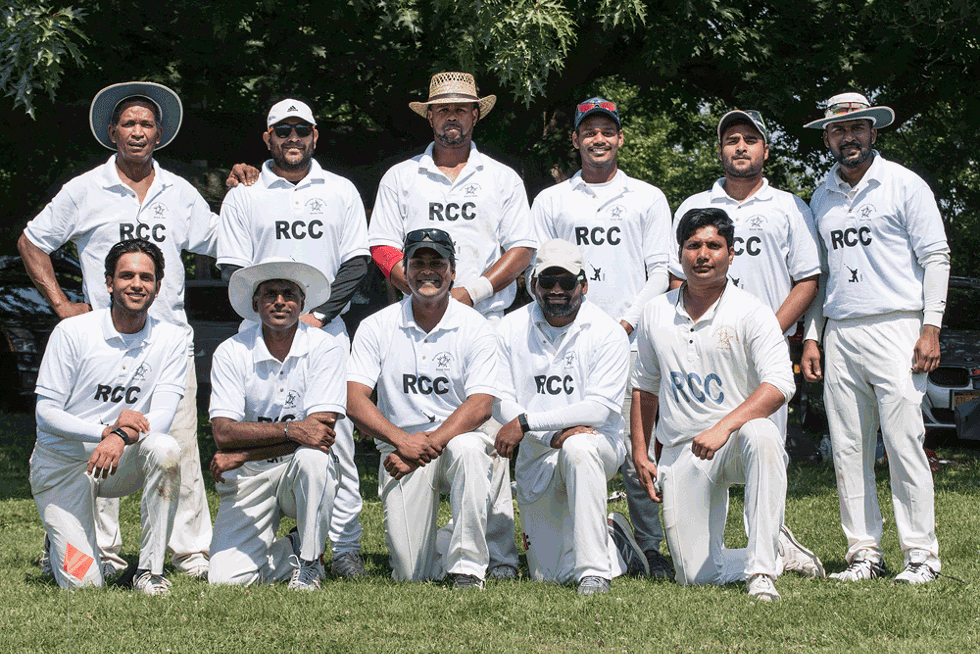[
{
"name": "500x250 Ad",
"insertPoint": "5",
"component": "15667920",
"parentWrapperClass": "",
"requiredCountToDisplay": "1"
}
]
This summer, as Sambit Mohapatra watched the Cricket World Cup on his living room television, his son watched him. Yuvaan, shy of his third birthday, didn't understand everything he was seeing, but his father's feelings – his shouts and celebratory jumps off their sofa at 6:30 in the morning – were unmistakable.
Yuvaan started asking, "What is cricket?" This curiosity resurfaced on Saturday mornings when Mohapatra, a member of the Rochester Cricket Club, grabbed a bat and pads before heading out the door. "What is that?" "What is that?" "What is cricket?"
Mohapatra is a vice captain and a top batsman for the oldest of Rochester's four men's cricket clubs. On summer weekends at Genesee Valley Park, he joins his RCC teammates to face opponents from across Western New York in one of the city's oldest sporting traditions. Matches unfold over entire afternoons, and when Mohapatra returns home, Yuvaan is awaiting a report.
"I want to train him to play cricket one day," Mohapatra, a computer engineer from India who now lives in Henrietta, says.
If history is an indicator, this will never happen. For 160 years, cricket has been the province of immigrants in Rochester, yet interest faded for their children. Without the game in schools, cricket lineages end as younger generations gravitate to mainstream American sports. No member of the four current local men's teams was born in the United States.
Today, however, there are signs homegrown cricket is on the upswing. Legislation from Albany may soon bolster existing grassroots efforts to give the world's second most popular sport a second chance with area youth. Local cricketers no longer just wish their children played cricket; they advocate to make it happen.
"I see him holding the bat. I see him with all the cricket conventions," Mohapatra says of Yuvaan. "If he starts liking another game, it would be unfair to push him toward cricket. But since I see this fire in him, since I see a colossal amount of interest in cricket, he will continue to play."
Mohapatra does not know when RCC will next have an American-born player. Nor does he know if Yuvaan will stick with the sport as he grows older. Mohapatra only knows that his son is already asking the right questions.
Invented in 17th-century England, cricket is a bat-and-ball game that stretched to every inch of the former British Empire. In cricket, a bowler hurls a cork ball encased in stitched-up leather toward a batter 22 yards away. The ball usually skips one time on a dirt lane, known as a pitch, before reaching the batsman, whose job, as in baseball, is to hit the ball where the other team isn't.
The flat bat head – slightly concave in the front, with two aerodynamic sides rising toward a center crease in the back – allows batters to spray shots in any direction. No area is foul territory, and the ball can be knocked forward, sideways, or (with deft angling) backwards.
Defenders respond by encircling the pitch, nine players staking positions around grass grounds. Their fielding stance is a slight crouch in anticipation before each bowl. The lack of gloves is conspicuous. A cricket ball is firm, and bare-hand catches can leave fingers bruised.
If batters make solid contact, they sprint, with bat still in hand, from one side of the pitch to the other until the defense retrieves the ball and fires it back. Each successful trip across the pitch nets one run. Hitting the ball beyond a circular outer boundary scores multiple runs. There are also wickets and overs and something called a golden duck.
The structure of the play is still evolving. Test cricket, the sport's most traditional format, lasts across several days. To fit the sensibilities of modern fans, shorter versions, including T20 and T30, were designed to conclude matches in a single afternoon or evening.
The first-ever cricket match in Rochester sounds miserable. In 1859, two years before the Civil War and a decade before Major League Baseball, an all-star outfit of 12 English cricketers toured five North American cities to "disseminate amongst all classes, that love of 'England's pastime,'" Fred Lillywhite, a reporter traveling with the team, wrote in his book "The English Cricketers' Trip to Canada and the United States." Sporting bushy sideburns and Victorian neckties, the men rode into Rochester in late October to begin a three-day exhibition against a collection of American and Canadian players. The temperature, according to Lillywhite, was frigid.
"Such cricketing weather had never before been experienced," he wrote. Players wore heavy coats and didn't know whether their numb, unfeeling hands had successfully caught balls until they actually looked. Many struggled to bend their knuckles to grip bats. One day was called off due to snow. "Immense excitement prevailed," Lillywhite wrote of the crowd that braved frost to witness this imported game. "But owing to the continued coldness of the weather, little could be done in the shape of showing what cricket was."
Despite imperfect conditions, the English Cricketers piqued local interest. Throughout the late 19th century, Rochesterians attended yearly exhibition matches. In 1911, the Rochester Cricket Club formed on the grounds of Genesee Valley Park, where it still plays today.
Since then, Rochester's immigration history can be traced, in part, through RCC. British expatriates filled rosters in the early decades. Starting mid-20th century, seasonal workers from Britain's Caribbean colonies began to supplement RCC's old guard.
In the early 1980's, Roderick Wilson and Mark Welch immigrated to Rochester (Wilson, from Jamaica, worked at a night club; Welch, from Barbados, enrolled in Monroe Community College). And they joined a Caribbean cohort that turned RCC into a powerhouse. "Nobody could beat us," Wilson says as he sits with Welch feet from the Genesee Valley Park grounds he once ran across. "We didn't just fool with local teams," he says. "We were one of the best in North America."
RCC made trips to the Bahamas, Barbados, and St. Vincent to challenge, and often beat, collections of the islands' best cricketers. RCC home matches, Welch says, attracted more than 2,000 spectators, who lined the grounds of Genesee Valley Park, pitched canopy tents, fired up grills, and turned the air redolent with Caribbean cuisine. "There were bleachers all over," Wilson adds, pointing to what is now empty grass beyond the cricket grounds.
During the years Wilson and Welch were going toe-to-toe with the top teams in the Western Hemisphere, Mohapatra was a child in the eastern Indian city of Bhubaneswar, dashing from school every afternoon with his older brother to their neighborhood pitch. "People in India don't need to be told about cricket," Mohapatra says. "They know it by default."
Mohapatra grew into one of Bhubaneswar's best cricketers and at 16 was asked to compete for his state team. Several years later he met Jangyaseni Mohanty, a fellow computer scientist engineer from a nearby city. They liked rival professional teams and teased each other when one squad topped the other.
Mohapatra and Jangyaseni married in June 2012, two months before Mohapatra's employer, IBM, relocated him to Rochester. Both feared the move might deny them cricket. "With 6 to 7 months of cold, I never expected I'd be able to get any cricket," Mohapatra says. "But I saw, in Buffalo, Syracuse, Albany, there was cricket all over."
The couple made up the third phase of RCC immigration. Over the past two decades, South Asia has become the dominant source of New York cricketers. Drawn to Rochester for higher education and work, 17 of the team's current 27 players came from India, a cricket-obsessed country of 1 billion. Like her husband, Jangyaseni hopes Yuvaan and his 11-month-old brother Mivaan will help make up a fourth wave of RCC cricketers: those raised in Rochester.
It's the last Saturday of July, a tolerably hot, sunny afternoon at Genesee Valley Park, and RCC is facing the Buffalo Niagara Cricket Club. Both teams wear white tops and white pants, and batters are suited up with full body pads, from their ankles to their chests.
RCC breaks a team huddle with a coordinated cheer before taking the field. Buffalo is to bat first.
The first RCC bowler takes a 15-step run up, as if he were charging an Olympic vault, before releasing a one-bouncer at the knees of the Buffalo batter. The batter hits a soft dribbler to his right – not a run-scoring play, but not a dreaded out, either. "Let's go, let's go. You have 10 hours," a Buffalo player calls out from the sidelines. "Ten hours" is hyperbole – an exaggeration to tell his teammate to be patient at bat – but his advice highlights cricket's leisurely pace. RCC cricket matches usually last around six hours.
Every few bowls, a Buffalo batter smacks a ball through a gap between fielders for a run. Scoring a run, or even a few, is viewed by Buffalo teammates with the enthusiasm you might exhibit after finding a dollar on the street: It's good, but you need a lot of them before it's meaningful. On this afternoon, Buffalo is aiming to score at least 150 runs.
When RCC makes an out – a fielder snags a ball mid-air, or the bowler makes the batter miss in a certain way – every fielder erupts in a paroxysm of joy: yelps, rapid fist pumps, jumping high-fives that feel discordant given the match's previous calm. After RCC makes its 10th out, Buffalo is finished batting for the day. Buffalo is stuck on 114 runs, so RCC takes its turn to bat, with 115 as its target.
As the match progresses, Divya Nerabetla, a dentist from India who now lives in Webster, stands cheering from just outside the circular boundary of the cricket grounds. Nerabetla's husband, Ram Desani, is fielding for RCC, and Nerabetla understands the endurance – both physical and mental – that cricket defense requires. In 2016, she and a group of other players' wives decided they should do more than watch their spouses play cricket. "We should start doing this," Nerabetla remembers thinking. She now captains RCC's women's team, a 10-person squad that competes every August at the Rustic Village Tournament in Henrietta.
Two members of the women's team, Brighton High School students Bhuvana Chimmiri and Dhaanya Ghanta, grew up in Rochester. From an early age, their fathers introduced them to the sport. In India, women have historically been kept away from cricket, but gender exclusions are breaking down.
"My friends go, 'Oh, I didn't know cricket was a huge thing here," Chimmiri says. "Since a lot of them play baseball or softball, they are very interested in knowing more."
The men's match enters its third hour, and Mark Welch and Roderick Wilson sit on one of the ground's few remaining bleachers, recalling past players and critiquing the current ones. "Did the batter forget he is supposed to be scoring runs?" Wilson asks out of the batter's earshot. "You can't score every time, Roderick," Welch responds. At 58, Welch has an emeritus roster spot and serves as club president.
He has three children, none of whom play cricket. To build stronger youth participation, Welch and other RCC members give cricket clinics at area schools, but he believes more cricket pitches are needed to sustain substantial interest. Genesee Valley Park has the only public pitch in Monroe County, but that might soon change.
In June, the New York state legislature approved a bill that would establish an Empire State Cricket Task Force. Citing the game's economic potential, the bill says the task force will "conduct a comprehensive study and create strategies to promote the game of cricket in New York State." The bill's co-sponsors envision a future where cricket tournaments play out in area stadiums, drawing fans and tax revenue.
"I think we all know when a sports event comes into a community, there is a big economic boost in terms of hotels, restaurants, and just getting to know the area," Assembly member Karen McMahon, a Democrat representing sections of Erie County, says. "So it could be a part of a tourism strategy down the road." After glimpsing an early draft of the bill on a colleague's desk, McMahon asked to be a co-sponsor. With many cricket-playing constituents, she hoped a prospective task force would have at least some Western New York representation.
The legislation awaits final approval from Governor Andrew Cuomo, who is expected to sign by the end of the year.
"Much of its impact remains to be seen," McMahon says of the task force, which would be the first of its kind in the country. "The more people know about cricket," she says, "the more popular it can be. And maybe at some point they go beyond teaching clinics and establish youth leagues."
An ideal candidate for any local little league cricket is Arjun Saduvu. A rising third grader in Pittsford, Arjun already plays little league baseball and dreams of being on the Boston Red Sox team. He also owns a starter cricket bat and absorbed World Cup broadcasts with a fervor even his father Vijay, a life-long cricket fan, couldn't muster. Like many his age, Arjun has split sporting allegiances.
At the RCC-Buffalo match, he stands by his father Vijay, an IT programmer from Hyderabad, India, who manages RCC's men's team. Arjun wears a cricket jersey and an adult helmet that swallows his face as he studies the game through the helmet's metal mask.
"Keeper is my favorite position," Arjun says of the position most akin to the catcher in baseball. "You get the ball a lot of times." Earlier this month, Arjun captained a team of child cricketers at the Rustic Village tournament. Around 30 children competed that day, the highest total in the tournament's 16-year history.
Vijay has tentative hopes that his son's passion will last beyond his adolescence. In addition to two players on the women's team, four men's players on Rochester's newest cricket team – the Rochester Greens Cricket Club – moved to the United States before the age of 10.
"Now, younger people are starting to play more," Vijay says. "If he were in India, I could see him as a professional cricketer. But we are here. So we have to see."

